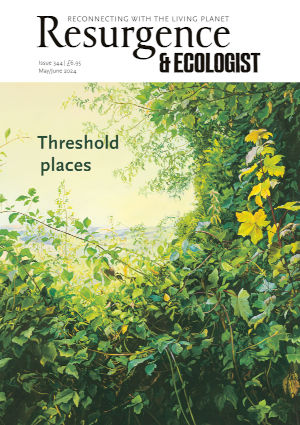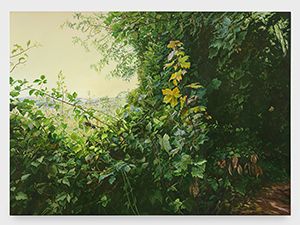We can’t change without passing from one place, one idea or one experience to another, and we can’t do that without courage. The theme of this issue is threshold places, and by those we mean those unseen and often unnoticed places where change is already afoot but where ‘what was’ is not quite ended and ‘what will become’ has not yet arrived.
This is where the magic happens, but navigating these spaces – and thus change – calls for courage from us all. And more than that, it calls for shared beliefs and deep trust.
In a way, every piece in this issue highlights some version of a threshold looming, being crossed or having been successfully negotiated. In her Slow Read article, Gail Bradbrook, a co-founder of the Extinction Rebellion activist movement, explores a liminal place in the world of activism and how a movement that crossed a major threshold – from sidelined limited attention to mainstream awareness – may yet need to cross another.
In his joyful rediscovery of Indian street art, Satish Kumar celebrates how life-affirming it is to cross the threshold that says we must engage with most art indoors, at a distance several feet back from the trip line and in hushed tones. And in our main theme, we share the thoughts of the late Irish poet and philosopher John O’Donohue on just why thresholds are so important and call for courage, before we go on to explore with other writers two big thresholds or rites of passage: birth and death.
Often for one thing to arrive, another must end, and this is never more evident in the natural world in temperate climates than when we change seasons. In Japan, it is now the time of cherry blossom (sakura), which is such an arresting and beautiful spectacle, and the practice of gathering and even picnicking outside under the blossoms in order to admire and celebrate them is called hanami, ‘flower viewing’.
People gather in their communities, not just to wonder at the beauty and vitality of the blossoms, but also to recognise the fragility of all things – here today, gone tomorrow. And in that culture sakura represents that exquisite contradiction of life co-existing alongside death, beauty alongside violence, and love alongside hate.
I went recently to the Hepworth gallery in Wakefield to see a show by the African American artist Sylvia Snowden called Painting Humanity, which runs until 3 November. I have been thinking about how, in many ways, that’s what these issues of Resurgence & Ecologist are all about: painting humanity (and its relationship to the planet and all we share it with) in all its glorious messiness – sometimes showing smallness, and sometimes wonderful generosity, but with above all things our ability to see and hopefully honour what matters, even if and perhaps especially when we cannot capture or hold on to it, because that precarity is what makes life here so precious for us all.








